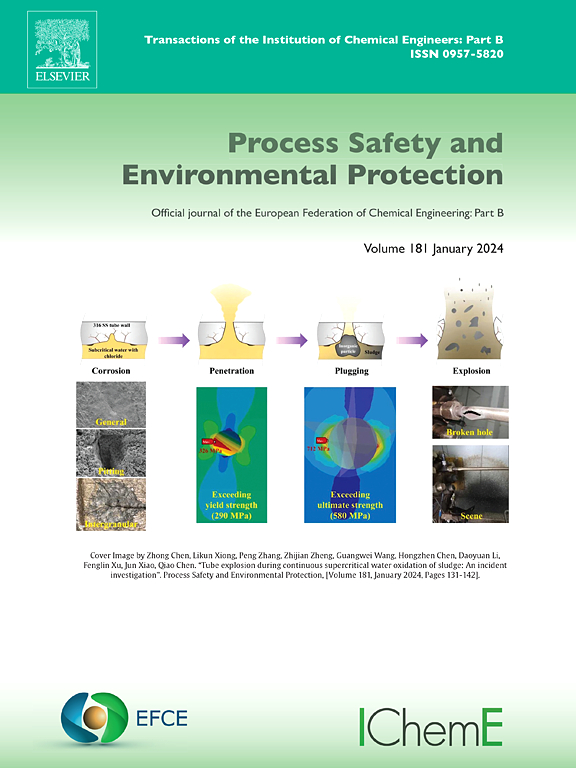基于低秩和对偶图嵌入的多模式过程监控特征转移投影
IF 6.9
2区 环境科学与生态学
Q1 ENGINEERING, CHEMICAL
引用次数: 0
摘要
一个复杂的工业过程通常会因为产品规格或原材料的不同而切换操作模式,从而导致多模式过程数据的分布可能不一致。这对传统的过程监控方法提出了挑战。本文提出了一种基于低秩对偶图嵌入的特征转移投影(FTPLG)方法,用于多模式过程监控,目的是捕获数据之间的信息表示。提出了一种多源加权平均差异对齐策略,用于缩小多模态间的精细尺度分布差异。学习了一个施加低秩约束的系数矩阵,使所提出的FTPLG捕获跨不同模式的共享信息。在此基础上,提出了一种对偶图正则化项来保留隐藏在多个模式中的关系,其中奖励图和惩罚图分别侧重于利用模式内的唯一性和模式之间的联系。有了这些独特的特征,FTPLG方法可以更深入地了解多模式过程。仿真过程和实际工业过程验证了该方法的有效性。在基准测试过程中,平均故障检出率提高了9 % ~ 28 %。本文章由计算机程序翻译,如有差异,请以英文原文为准。
Feature transfer projection with low-rank and dual graph embedding for multimode process monitoring
A complicated industrial process in general switches operation modes because of varying product specifications or raw materials, resulting in the distribution of multimodal process data may be inconsistent. It poses challenges to traditional process monitoring methods. In this paper, a feature transfer projection with low-rank and dual graph embedding (FTPLG) approach is proposed for multimode process monitoring, with the aim of capturing the informative representation among data. A multi-source weighted mean discrepancy alignment strategy is proposed for fine-scale distribution discrepancy reduction among multiple modes. A coefficient matrix imposed low-rank constraint is learned so that the proposed FTPLG captures shared information across different modes. Moreover, a dual graph regularization term is developed to preserve the relationships hidden in multiple modes, in which a reward graph and penalty graph focus on exploiting uniqueness within modes and connections between modes, respectively. With these distinctive characterizations, the FTPLG approach provides deeper insights into the multimodal processes. A simulated process and a real industrial process are carried out to demonstrate the effectiveness of the proposed approach. The average fault detection is improved by 9 %-28 % in the benchmark process.
求助全文
通过发布文献求助,成功后即可免费获取论文全文。
去求助
来源期刊

Process Safety and Environmental Protection
环境科学-工程:化工
CiteScore
11.40
自引率
15.40%
发文量
929
审稿时长
8.0 months
期刊介绍:
The Process Safety and Environmental Protection (PSEP) journal is a leading international publication that focuses on the publication of high-quality, original research papers in the field of engineering, specifically those related to the safety of industrial processes and environmental protection. The journal encourages submissions that present new developments in safety and environmental aspects, particularly those that show how research findings can be applied in process engineering design and practice.
PSEP is particularly interested in research that brings fresh perspectives to established engineering principles, identifies unsolved problems, or suggests directions for future research. The journal also values contributions that push the boundaries of traditional engineering and welcomes multidisciplinary papers.
PSEP's articles are abstracted and indexed by a range of databases and services, which helps to ensure that the journal's research is accessible and recognized in the academic and professional communities. These databases include ANTE, Chemical Abstracts, Chemical Hazards in Industry, Current Contents, Elsevier Engineering Information database, Pascal Francis, Web of Science, Scopus, Engineering Information Database EnCompass LIT (Elsevier), and INSPEC. This wide coverage facilitates the dissemination of the journal's content to a global audience interested in process safety and environmental engineering.
 求助内容:
求助内容: 应助结果提醒方式:
应助结果提醒方式:


